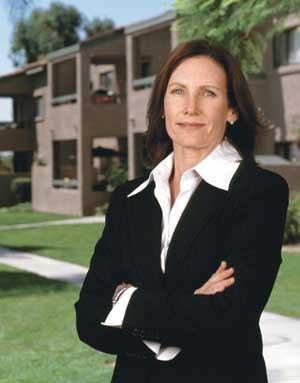Capital Plans In another efficiency improvement, Clark brought in a manager to oversee property improvements and upgrades. “Our assets are going to be with us in perpetuity,” explains Clark. “We want to have long-term viability. So, it’s important to take care of the buildings.”
When Clark arrived, no capital improvement plan was in place. She instituted a five-year plan along with a one-year action plan but soon realized that wasn’t enough. The company needed to take a deeper look into its operating systems. So, it instituted a 15-year physical needs assessment, which looked at every system on every property – things like asphalt on the roof, HVAC, utilities, windows, and interiors. Out of that grew a schedule for replacing everything from countertops to cabinets. Implemented last year, the program is tied to the five-year capital improvement plan.
In another deft move, Clark created a compliance department to ensure that the company abides by regulations. SoCal Housing must use many complicated layers of financing, all with attendant regulations, to develop its projects. For instance, tax-credit projects must be maintained affordable for people earning 35 percent to 60 percent of the area median income (AMI). In order to receive money from certain lenders, the company needs to certify that their construction workers are being paid prevailing wages. Another regulation includes maintaining the affordability status of the community for a minimum set of years – typically 30 to 55 years.
The department, says Clark, operates very smoothly, assuring the company can continue to tap financial sources to fuel its growth. “We have had very successful audits without any trouble.”
Forging Ahead Getting organized, of course, is just the first step – albeit the most important one – in being a successful nonprofit affordable housing provider. Nonprofits must still leverage their efficiency to compete in the marketplace. SoCal Housing believes it has an edge over other nonprofits because it’s managed like it is a for-profit company.
The company is structured with four operating companies – development, construction, property management, and social housing. “Their in-house management and expertise provides an unique opportunity,” says Frank Cardone, COO of the Related Cos. of California, which has done several joint-venture deals with SoCal Housing. “They provide input on what would make the long-term viability of a community more prosperous.”
While SoCal Housing’s operating companies play a vital role in its success, so does its business relationships. Clark “brings a governmental perspective with a blend of entrepreneurial spirit to the job,” says Burum. Prior to joining SoCal Housing, she was director of housing development and construction management for Los Angeles County’s Community Development Commission.
“Being able to deal with social and political aspects is important to affordable housing,” says Cardone. “She brings both sides to the table. She understands how governmental agencies view development projects and how the world in general will look at a project.”
Clark’s perspective is especially important because SoCal Housing almost always acquires or develops a project in conjunction with local governments. In fact, the nonprofit is often brought in at the request of local government. “The goal is to work in partnership with local municipalities to help them with whatever they define as their problems,” says Clark.
When the company began, the market mostly supported acquisition rehab. Now the company is doing both rehab and new construction because that is what the communities need, explains Clark. SoCal Housing will even work with redevelopment agencies to help them meet their goals of strengthening the community and reducing blight.
The organization worked with San Diego County to revive Vista del Sol, a 16-building, 132-unit affordable housing community in National City. The area was riddled with gangs, crime, and prostitution; parents didn’t let their kids go outside and play. Eleven individuals owned the buildings. “So in partnership with the city, we went in and acquired those buildings and rehabbed them,” says Clark.
Renaissance Village, another challenging acquisition rehab projects, was the first place that Teri Hoerntlein, the property manager, heard gunshots. When she took over the 144-unit community in Rialto, Calif., 22 residents were in the eviction process. She doubled that number in the first week. “There were some good people living there, but there were a lot of undesirable people that were involved in criminal activity and not paying their rent,” says Clark.
SoCal Housing institutes a crime-free addendum to its leases and works closely with the police. The company, by policy, will evict residents for participating in illegal activity. But when it takes over a property, it gives residents a chance to clean up and be good community members. “If that fails to happen, they are put through the eviction process,” says Clark.
